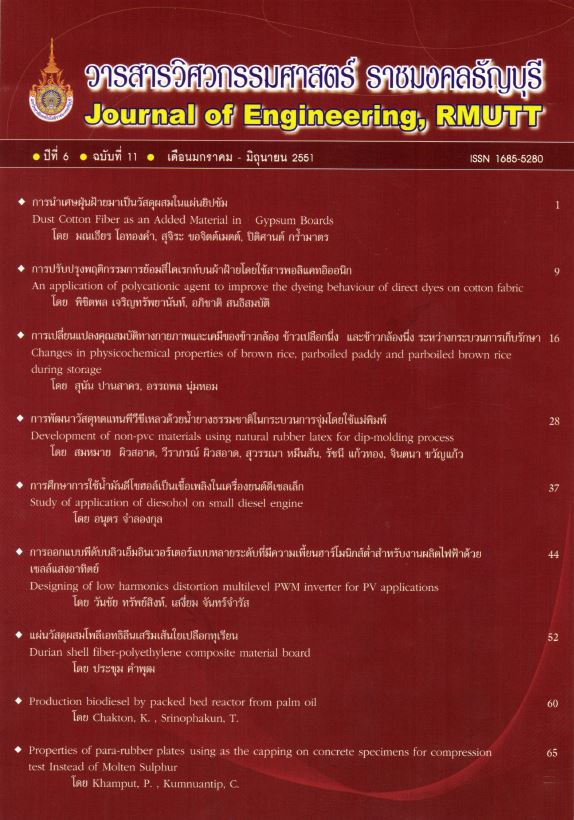Properties of Para-Rubber Plates Using as the Capping on Concrete Specimens for Compression Test Instead of Molten Sulphur
Main Article Content
Abstract
This paper aims to study the using para-rubber plate for transferring the force on concrete specimens instead of capping with sulphur. Four formulas for mix design of para-rubber plate are setup. Each formula is mixed in two rolls mill machine and formed the para-rubber plate by Compression Molding. After obtaining the para-rubber plate specimens, the measuring of compression set, tensile strength, 7o sttain, tear strength, hardness of para-rubber plate are performed. Consequently, the para-rubber plates are taken into capping the concrete and tested the compressive strength. These results are compared to that with sulphur capping. From the results, it is found that adding carbon black over 60 phr affects to develop the hardness but the other properties are declined. In testing the compressive strength of concrete with para-rubber plate, it is found that the formula having the results close to that using of sulphur is the formula that using latex at 100 phr, carbon black (grade N330) at 100 phr and calcium carbonate at 50 phr. In this formula, the compressive strength is larger than using sulphur at7Vo. This indicates that there is possibility in developing the formula of para-rubber plate for capping material in the future
Article Details
The manuscript, information, content, picture and so forth which were published on Frontiers in engineering innovation research has been a copyright of this journal only. There is not allow anyone or any organize to duplicate all content or some document for unethical publication.
References
Method of Making Test Cube from Fresh Concrete, British Standard Institute, BS 1881: Part 108,1983.
ASTM C192/C192 M-00: Standard Practice for Making and Curing Concrete Test Specimens
in the Laboratory, Annual Book of ASTM Standards. Volume 04.02, 2001.
ASTM C617-98: Standard Practice for Capping for cylindrical Concrete Specimens, Annual Book of ASTM Standards. Volume 04.02, 2001.
P.M. Carrasquillo, and R.L. Carrasquillo,"Effect of using unbounded capping systems on the compressive strength of concrete cylinders," ACI Materials Journal, vol. 85,no. 3, pp. 141-147, 1988.
J.S. Grygiell, and D.E. Amsler, "Capping concrete cylinders with neoprene pads,"Research Report, New York State Department of Transportation, Albany. No.46, 1977.
P. Khamput and A. Boksuwan, "A study of compressive strength of concrete capping with Neoprene," Technology and Innovation for sustainable development Conference,Khon Kaen. 2006.
M. Anusiri, "The applications of bagasse paper for replacing sulphur in capping cylindrical concrete head," NCCE 11,Phuket. 2006.
P. Sae-Oui, Rubber: types, properties and usage, MTEC, Prathumthani. 2004.
American Society for Testing and Materials,Annual Book of ASTM Standards. 1996.
ASTM C39/C39M-01: Standard Test Method for Compressive Strength of Cylindrical Concrete Specimens, Annual Book of ASTM Standards. Volume 04.02, 2001.
N. Na-Ranong, Testing for mechanical properties of rubber, Rubber Technology Division, Rubber Research Institute, Department of Agriculture, Bangkok, 2001.
S. Chuayjuljit, Rubber Technology, Department of Science, Chulalongkorn University,Bangkok. 2005.


